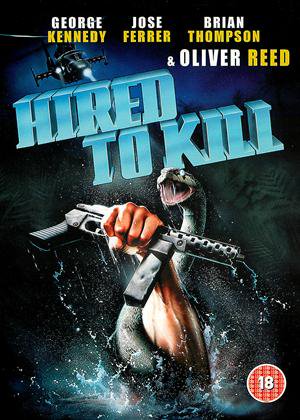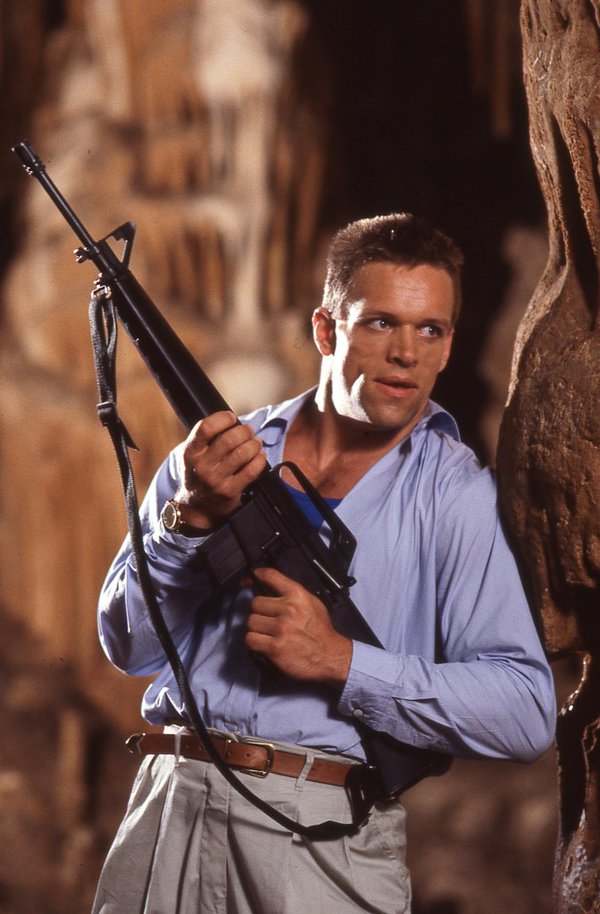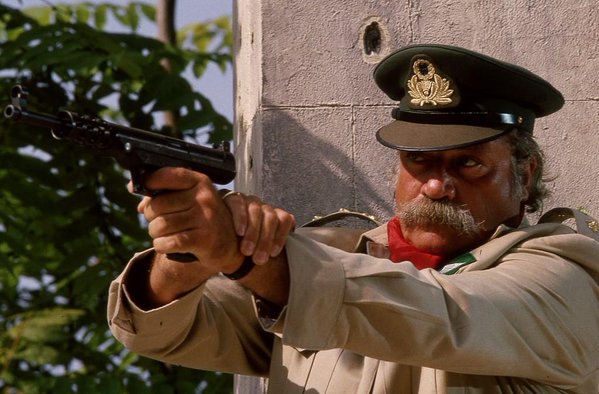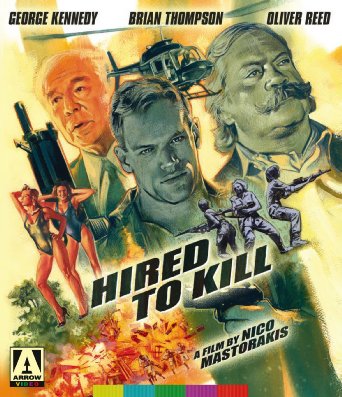In extreme moments, we are revealed. And in that revelation, there exists a forward momentum.
Early action and adventure movies, in the first years of cinema, were romps, swashbucklers, period pieces, pirate movies, war movies, sword-and-sandals epics. The American Western, maybe the single most dominant action category of the first half of the twentieth century, is most often credited with providing moral coding in the costuming — the men in the white hats, fending off those in the black. Of course, many great Westerns explored more complicated worldviews, but even those — MY DARLING CLEMENTINE, THE NAKED SPUR, THE SEARCHERS — tended to end in favor of the right side in the final reel. Justice would always be served. The film noir genre contains specific action trappings — guns, fistfights, car chases — but noir was moody, morally nebulous, doom-laden, in a way a straight-up action film would never slow down enough to be.
When we’re talking about action films, we’re talking about formula. No matter the creative spin on the standard, no matter the high concept at play, action cinema gives us a man, sometimes a woman, a pair of fists, sometimes a gun, an enemy to be defeated, sometimes sex, always physical conflict, and the notion that no matter the cost accrued along the way, the good guy stands victorious in the end. The Western fell out of favor in the early 1970s, despite sporadic returns, and the crime films of the 1970s, particularly in the seedier subgenres like vigilante films and revenge pictures, kept action going until something new could arrive.
The 1980s were a critical decade for the American action film. Whether it was due to the prevailing political mood of the day or due to the advancing technological developments of action moviemaking or both, action films as a movement veered away from deep thinking or any kind of self-reflection. In the action films of the 1980s, there was rarely a problem that couldn’t be solved with muscles and big guns. Much of the moral agonizing of the films of the 1970s was stripped away in favor of directness and pyrotechnics. Charles Bronson’s movies got more morally simplistic, and arguably more sadistic. Burt Reynolds — almost willingly it seems — aged out of the genre. Clint Eastwood developed more highbrow thematic interests. Stallone and Schwarzenegger were the burly, taciturn type-As of the day, always smarter and craftier than they seemed, but not that much. Even the B-team — Kurt Russell, Van Damme, Norris, Seagal — were the big type-A fish in their slightly smaller ponds. Bruce Willis was an outlier, making plenty of the kinds of movies Stallone and Schwarzenegger were known for making, but often smirking his way through them. He had an easier transition into the 1990s and the 2000s than those two did, since in the latter decades, action movies became the territory of less-physically-imposing, assertive-not-aggressive stars like Tom Cruise and Will Smith. (Nowadays you only need a muscular physique in order to get the superhero suit to fit.)
If you noticed all these action stars mentioned so far happen to be male, well yeah, that’s why Pam Grier was so important for a few beautiful years in the 1970s, and so badly missed very soon afterward. The 1980s were a particularly bad era in action films to find oneself female. Women were love interests, martyrs, cannon fodder, sex objects, sidekicks, henchmen, even villains, but almost never the protagonist. If there was something a little buried in our fascination with all these oiled-up biceps, that’d be a conversation maybe between a guy and his priest.

The 1980s were a period of cartoonish macho excess on screen by any reasonable standard, but HIRED TO KILL — co-directed by Peter Rader and then the Greek exploitation legend Nico Mastorakis, and not to be confused with HARD TO KILL — makes movies like PREDATOR and ROBOCOP look mannered and restrained by comparison. If Eighties’ploitation is a viable term for a genre, then this is the most jam-packed example of it. This movie is what the action movies of the 1980s would write themselves, if they could see past their creative differences long enough to collaborate (and if they could use a typewriter). This movie looks like if Andy Sidaris had directed STONE COLD.
As a brief crash course to explain those references: Andy Sidaris was a B-movie director whose unabashedly heterosexual movies were showcases for huge boobs, angry-looking ordinance, and explosions, while STONE COLD is an action movie from 1991 which seems determined to cram every single convention of the action movies of the previous decade into 95 minutes of skull-crunching calamity. The dirty secret of STONE COLD, directed by stunt coordinator Craig R. Baxley, is that it’s technically a well-made film, as preposterous as its story is and its performances are. And if Andy Sidaris wasn’t quite the filmmaker Russ Meyer was, neither did he ever make a dull movie. He had a knack for tapping into the Cro-Magnon impulses — for sex! for violence! for combustion! — that more civilized men may struggle to repress.

HIRED TO KILL opens with a muscular blond giant snoozing in his underwear on board his yacht. (We assume the yacht belongs to him, but you never know.) A phone rings and wakes him up, so he shoots it into pieces with a massive handgun, as you do when you’re the hero of a 1980s action movie. This man is Frank Ryan, a mercenary who is called into action by a man named Mr. Thomas (the ever-reliable character actor George Kennedy) to head to a country called Cypra in order to liberate a revolutionary leader (José Ferrer) from the prison and the rule of a vindictive tyrant (Oliver Reed). HIRED TO KILL, as do so many he-man action movies of the 1980s, has a pseudo-political plotline a la COMMANDO that’s sort of a bastardized version of what happens in so many James Bond movies. The difference here is how Thomas wants Ryan to go in: Undercover, in the identity of a fashion photographer named Cecil Thornton, traveling with seven glamorous models. The models will, in fact, be highly trained operatives Ryan is to go recruit from firing ranges and prisons, even though he doesn’t like or trust women. We know this about him because he says he doesn’t like or trust women.

Frank Ryan is played by an actor named Brian Thompson, a journeyman character actor best recognized by ’80s-action enthusiasts as the ‘Night Slasher,’ the deranged monolith who was a healthy match for Stallone in COBRA. (I know him from his role on Buffy The Vampire Slayer, but I’m a weirdo like that.) Brian Thompson is a unique-looking guy, handsome in a way that’s sort of absurd — it’s like somebody put Willem Dafoe’s profile on Dolph Lundgren’s body. He also has a killer deadpan — it’s quite apparent that Brian Thompson the actor is a far wittier human being than the one he’s called upon to play in HIRED TO KILL. Frank Ryan is a racist, a misanthrope, a misogynist, and to top it off, apparently a homophobe. Look at what happens when the ultra-macho Ryan is informed by Thomas of the persona he will be embodying in this mission:
RYAN
You want me to be some faggot designer?
THOMAS
(considers the idea)
Faggot. Yes. That’s very good!
Well, here in the year 2016 we’re going to have to reckon with that sort of language. It’s surprising now, but it wasn’t uncommon then. I feel like somewhere in a vault is a BAMBOOZLED-style montage of unfortunate usages of that particular word throughout the 1980s. If it was rough seas being a woman in ’80s action movies, it was surely hostile territory for gay people. Of the top of my head, the only gay-friendly genre movie I can think of is KNIGHTRIDERS, and that hardly counts as an action movie. Usually in the action films of the 1980s, gay people were invisible, if not used for punchlines, and any kind of sexuality other than the most rugged and aggressive masculinity was scarce at best. If a man was effete, he was probably a villain. Men were men and women were women, and that was it. Certainly the majority of drag scenes in the genre of the era — i.e. Kurt Russell in TANGO & CASH or John Candy in ARMED & DANGEROUS (or WHO’S HARRY CRUMB? or NOTHING BUT TROUBLE) — were intended as comedy, not sincere experimentation. Honestly we’re still a fair distance from progressive in this arena — I’ve long thought it’d be fascinating and creatively fertile to have the next James Bond be a gay guy, with all the “Bond Girls” gender-flipped, but try selling that pitch. The superhero era — DEADPOOL, whatever else you want to say about it, being a recent encouraging counter-example — has been remarkably chaste.

This is an issue to dwell on in the case of HIRED TO KILL, because HIRED TO KILL veers off in some thrillingly unusual directions for a film of its vintage. Frank Ryan, a character so manly he has two male first names, makes a point of his antipathy towards women. He sneers at every woman he meets, and he has to go recruit half a dozen of them during the course of the movie, so we see him doing a lot of sneering.
Again, since the action movies of the era were a grab-bag of accumulated conventions from the favored genres of earlier eras, HIRED TO KILL is indebted to Westerns and war films like THE MAGNIFICENT SEVEN and THE DIRTY DOZEN in equal measure. Frank has to find a handful of women who are both beautiful and deadly, and once he finds them, he alone needs to train them to be able to both be convincing as international fashion models and as a finely-honed squadron of guerilla fighters. He tells them, “Ladies, you’re going to Hell. My job — and I hate it — is to train you as a team. You’ve gotta look good, move well, and kill quick.” He makes it clear how arduous his assigned task is. As Frank says when arguing the so-called perfect plan with one of his teammates, “Nothing is perfect when women are involved. From Eve to Margaret Thatcher, you’ve managed to screw up history.”

Frank and his women arrive in Cypra and make an impression on the man running the place, Bartos, who is played by Oliver Reed in a sort of caricature of Oliver Reed. Bartos guzzles wine and paws at women, speaking in an indecipherable accent that could be referred to as — not Greek — “Greasy,” maybe. (The movie was largely shot in Greece, so we’ll peg it in that general vicinity.) Reed, a legendary lush, sort of staggers through the movie — he’s intimidating, but maybe more as a signpost of former virility gone to seed, a former force of nature who’s slowing down with sogginess. He isn’t in the movie all that much, but his key scene with Brian Thompson is remarkable, and startling, for its era and even for today.

Being as how Frank Ryan is posing as a gay fashion designer, there is going to come a time in the film where the movie’s villain feels he needs to test the gay fashion designer’s cover story. Here’s how he does it: Bartos summons ‘Cecil Thornton’ to his room, where he tempts him by presenting and groping the bosom of the woman named Ana who is his most frequent companion (and who is also a double-agent and ally of the undercover fashion commandos, but that’s another story).

In one of the least erotic meant-to-be-erotic scenes you could imagine, Bartos stands behind Ana and pulls down the top of her gown, breathing heavily and staring at ‘Thornton,’ apparently to see if he’s literally getting a rise out of him. When Ryan calmly asks for a refill on his wine, not betraying any sign of tell-tale homosexuality, Bartos angrily dismisses Ana, and strides over to Ryan. Alone together, Bartos makes one final check, by reaching below the camera line, and conducting a feel test of the suspicious package. Bartos finally seems convinced, but just to make sure, Ryan leans in and…
Kisses him on the mouth.
Again. Just to reiterate. This is a crude, violent, cartoonishly sexist muscle-man action-movie where the hero kisses the villain on the mouth.



The significance of this moment is worth considering. Countless are the times when I’ve watched an action movie from the decade and wondered aloud, “Why don’t these guys just kiss already?” But for all the obvious homoeroticism on display all throughout the 1980s, I don’t think there’s another example of anything like this particular plot twist happening. (There’s a throwaway joke in 2010’s MacGRUBER to that effect, but it isn’t a significant plot point.) Now, within the context of HIRED TO KILL, neither character is gay, Ryan as ‘Thornton’ is only playing a role, and in fact Bartos takes a handkerchief and wipes off his mouth soon after the moment has passed, but it’s also true that neither character seems as outwardly or even secretly repulsed as you might have expected, say, Arnold Schwarzenegger to play it. In the following scene, Ryan calls Thomas to update him, making no mention of what he just did to prove his orientation. It’s never mentioned again. But it happened.
You’d never, ever, never see one of the marquee action stars of the era perform in a scene like this one. Most of those guys vote Republican, not for nothing. It took Brian Thompson, a trained actor with a background in musical theater who just happened to have the build of a Carpathian, to bring this accidentally progressive moment to life. Still not sure how they convinced Oliver Reed to do it, but he’s European and he lived through the ‘sixties and the ‘seventies, so who knows where his personal boundaries were. The movie continues to operate without displaying much awareness of how iconoclastic an incident this is. And so did movies in general.
This isn’t action cinema’s lost turning point. Gay themes remain the province of the underground and the prestige. We’re still not likely to get the big-budget action-movie version of BROKEBACK MOUNTAIN anytime soon, or a FAST & FURIOUS movie where Dwayne Johnson and Vin Diesel finally consummate their obvious attraction. History is unlikely to remember HIRED TO KILL as a watershed moment in cinematic depictions of gender and sexuality. But I continue to argue that this stuff matters, that this is the reason why we need to pay attention to our exploitation films: Because they’re willing to go further and to push harder than the mainstream stuff, even the critical darlings, they end up blazing a path towards freedom and enlightenment. Even if they don’t necessarily do it on purpose.
A reasonable question now: Am I making too much of what is, in the construction of the film HIRED TO KILL, a throw-away moment? Maybe. Probably. But also consider that soon after the moment in question transpires, Ryan’s bilious Trump-like position on women starts to thaw. When a member of his all-female commando squad is killed in action, he calls out her name in the most dramatic fashion — “SheilaAAAAAAAAAAAAAAAAAAAAA!!!” — and later, he has an awkwardly staged love scene with another one of his teammates, shot largely in ill-framed close-ups of either participant but still far more tender than any of the film’s prior leering moments of horniness. Frank never exactly says he was wrong about the ladies, but he lightens up a whole lot, even smiles at the once, and seems to appreciate their contributions to the mission once they inevitably succeed and fly off in a helicopter together. By breaking his rule about never working with women, Frank Ryan becomes a better man. Maybe buried within the messiness of HIRED TO KILL are the stirrings of a lesson in the making.

HIRED TO KILL arrived on Tuesday May 17th in the U.S. in a resplendent Blu-Ray package, courtesy of Arrow Video.
— JON ABRAMS.
- [THE BIG QUESTION] WHAT’S YOUR FAVORITE FEMALE ENSEMBLE IN MOVIES? - July 22, 2016
- [IN THEATERS NOW] THE BOY (2016) - January 24, 2016
- Cult Movie Mania Releases Lucio Fulci Limited Edition VHS Sets - January 5, 2016
Tags: arrow video, Barbara Lee Alexander, Brian Thompson, Columns, George Kennedy, Greece, José Ferrer, men, Movies Of The Damned, Nico Mastorakis, Oliver Reed, Peter Rader, politics, The World, violence, women








Isn’t Barbara Lee Alexander also Barbara Niven, because she married David Niven Jr soon after?